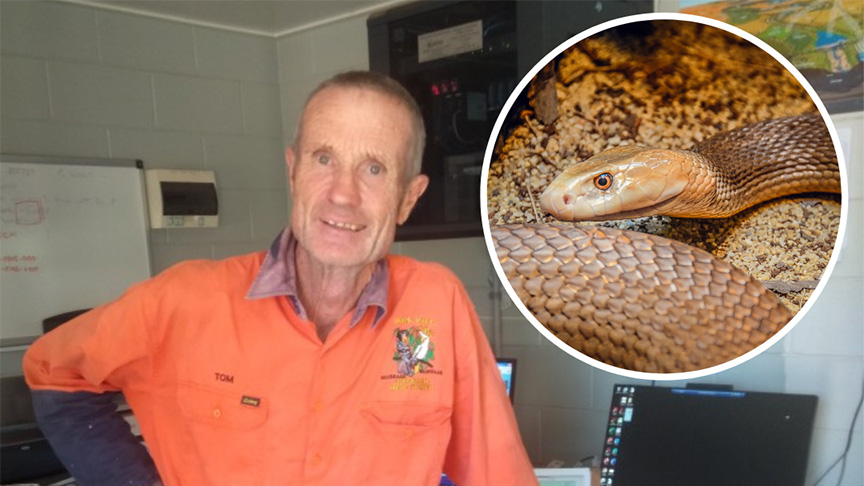
A Far Northern farmer who was hospitalised after being bitten by one of the world’s most venomous snakes initially thought he had trodden on a thorny weed hidden in the grass in his backyard.
Tom Jones, 66, had just finished a long morning of work at his farm about 35km outside of Cooktown and was ready to relax at home, when he spotted a sprinkler in his yard that needed to be shifted.
Mr Jones ventured a short distance out into the yard, barefoot, when he felt a sharp pain on the side of his big toe on his left foot as he walked past a patch of long grass.
‘It felt like I’d trodden on sensitive weed, but I couldn’t see any of it anywhere,’ he said.
‘There was a split second where I thought ‘hang on, my foot was lifted off the ground when this happened, and it didn’t add up.
‘I looked around and there he was behind me: his body zigzag shaped, with his head up in the air.
‘I just took a few seconds to have a look at him: the shape of his head, the colour of him, and things like that.
‘I thought ‘bloody hell, I know what’s happening here’ – I’d been bitten by a taipan.’
The coastal taipan, which is found throughout north-eastern Queensland and the Northern Territory, is a dangerously venomous species with strongly neurotoxic venom.
It possesses the third most toxic land snake venom known, and many human deaths have resulted from bites by this species.
Mr Jones administered first aid on himself, wrapping his leg up tightly in a compression bandage. He then drove to Cooktown Hospital’s Emergency Department.
After receiving emergency care, he was kept in hospital for observation. Clinicians initially believed he had received a ‘dry’ bite, without venom being injected into his bloodstream by the snake’s sharp fangs.
About 10 hours later, however, things took a turn for the worse.
‘I started getting double vision and then they realised I’d been envenomated,’ Mr Jones said.
‘The Royal Flying Doctor Service came, and they ran me to the airport. I was in Cairns within about 15 minutes.’
At Cairns Hospital, Mr Jones’ condition had deteriorated further as the strong venom from the snake took hold within his blood, affecting its ability to clot.
‘I couldn’t maintain blood pressure, and there was bleeding in my mouth,’ Mr Jones said.
‘That’s when they decided to give me the antivenom.’
Once the antivenom was administered to Mr Jones, he described the feeling as having ‘the worst hangover in the world.’
‘I had sweat pouring off me as soon as they started pumping the antivenom into me,’ he said.
‘Once they got it in there, I was still crook, but I felt better – it was a hungover feeling: the worst you’ve ever had. And the feeling didn’t go away.
‘They ended up giving me medication for the nausea, but I still had double vision, and felt sick in the gut.
‘I couldn’t open my eyelids and couldn’t swallow properly.
‘But by the next morning, things were much better.’
Cairns Hospital toxicologist Dr Mark Little said Mr Jones was lucky to survive the snake bite, as taipan venom could cause bleeding, muscle break down, as well as paralysis.
‘Tom potentially had a number of life-threatening complications due to his taipan bite,’ he said.
‘The Emergency Department team worked very hard to stabilise his condition.’
Mr Jones was under no illusion about how lucky he was to have survived his taipan encounter.
‘Dr Little told me to go and buy a lottery ticket, because obviously my luck was still holding,’ he said.
‘I never ever go anywhere without my boots on, ever.’
First aid for snake bites
If you are unlucky enough to be bitten, here is what you should and should not do. Assume all snakes are venomous, and take the following action:
- Do not panic. Try to remain calm, lie down and immobilise the bitten area. It is unlikely that the bite will be life-threatening.
- Apply a bandage but do not block circulation. Take a broad bandage (preferably elasticised) and bind along the limb starting at the bite area, at the same pressure as for a sprain. Then bandage down the limb and continue back up the entire limb over and above the bite area. This will help prevent the spread of the venom through the body. Do not remove the bandage. It is often easier to go over the top of clothing such as jeans rather than remove clothing. In an emergency, strips of clothing or pantyhose can be used instead of a bandage.
- Immobilise the limb with a splint. Lie down and keep the limb completely still until help arrives. Do not elevate the limb or attempt to walk or run. Movement will encourage the spread of the venom through the body.
- Do not attempt to catch the snake. All too often, the snake will bite again if an attempt is made to catch it. Identification of the snake species can be obtained through samples of the patient's blood or urine, and from venom around the bite area. If the species of snake still remains uncertain, a poly-antivenom may be used, which is suitable for treatment of all venomous snake bites.
- Do not wash the wound. Venom left on the skin will help doctors identify the snake and administer the appropriate antivenom.
- Do not cut the wound. This will spread the venom into the bloodstream and can cause more serious injuries than the snake bite itself.
- Seek medical help. An antivenom may be required.